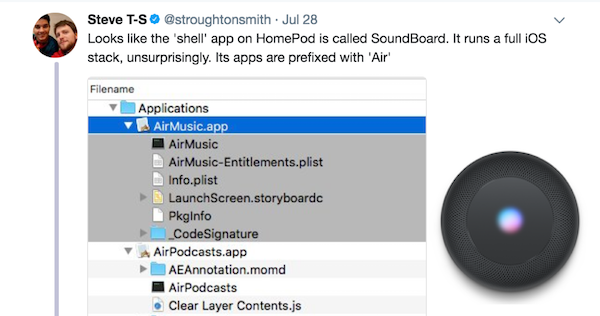Apple HomePod Includes Full iOS Stack
MacRumors found some tweets by developer Steve Troughton-Smith who was reviewing HomePod firmware that Apple pushed out Friday. The biggest revelation was that the full iOS stack will be available on the device which is likely why the A8 processor was included.
Looks like the ‘shell’ app on HomePod is called SoundBoard. It runs a full iOS stack, unsurprisingly. Its apps are prefixed with ‘Air’ pic.twitter.com/IPFF0vV3UT
— Steve T-S (@stroughtonsmith) July 28, 2017
It also appears to have App Store connectivity and is recognized as an iPhone SE. One commenter suggested that may be a factor of the A8 processor onboard is similar to the SE line of devices.
…it also pretends to be an iPhone SE to the iTunes Store, because reasons? ???? pic.twitter.com/6gFP0OufG8
— Steve T-S (@stroughtonsmith) July 28, 2017
The other interesting finding was the screen on the top is a full LED display which means the device could provide additional visual information on top. I’m not convinced that is a great user experience for a device designed to interact with from a distance, but it could be particularly useful for some on-device controls and configuration.
So the #HomePod probably has a screen like this. If it’s the right density could easily show basic things like temperature & weather icons ???? pic.twitter.com/l5f16EkddV
— Alan Miller (@rosewoodat5th) July 28, 2017
With all of this in mind, Troughton-Smith acknowledged that the documentation wasn’t particularly exciting. It looks a lot like any other iOS device we are familiar with except it doesn’t have a screen.
…I don’t know that there’s much else to say about HomePod other than this. From what I can tell it’s just all of iOS on a device sans screen
— Steve T-S (@stroughtonsmith) July 28, 2017
Making Apple HomePod iOS Developer Friendly
The full iOS stack inclusion might be the most important element of the HomePod’s future prospects. Apple has 16 million iOS developers to draw upon. The fastest way to get them productive developing voice-first applications is to provide a programming framework that they already understand.
This brings us back to the A8 processor onboard the HomePod. All of the other smart speakers released to date are using low end processors that operate essentially dumb devices reliant on the cloud for their smarts. Many people thought that the greater processing power was required for the device’s much-hyped sound and room mapping elements. However, Apple is clearly looking at more device-based processing and a more robust local services that may lead to new applications or features.
The Underwhelming Apple HomePod Launch. Blame it on Siri and Maps.









